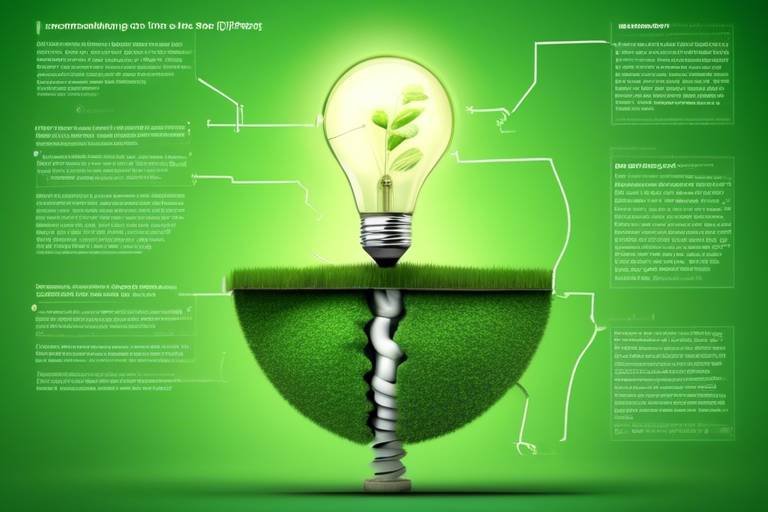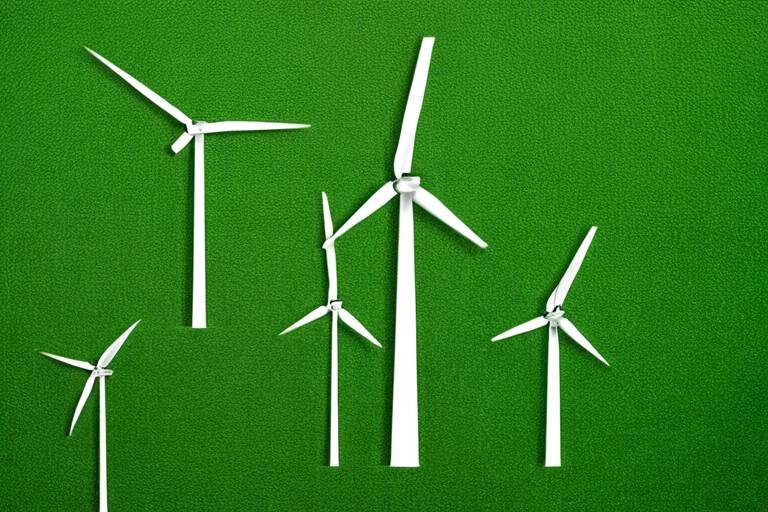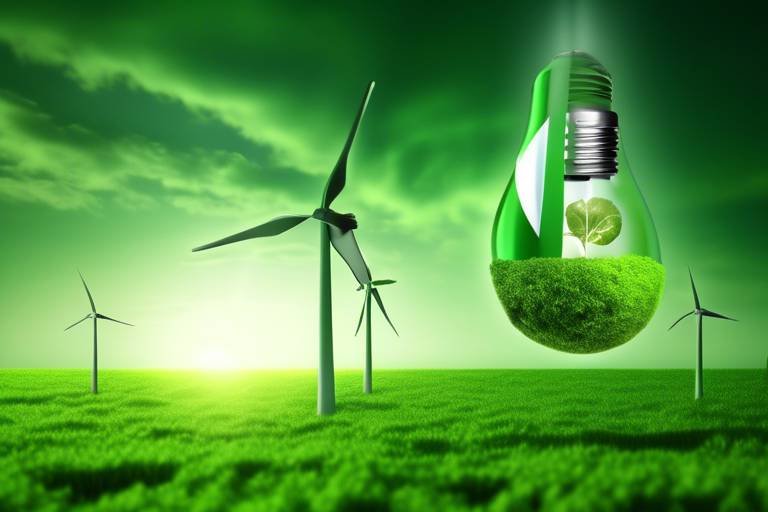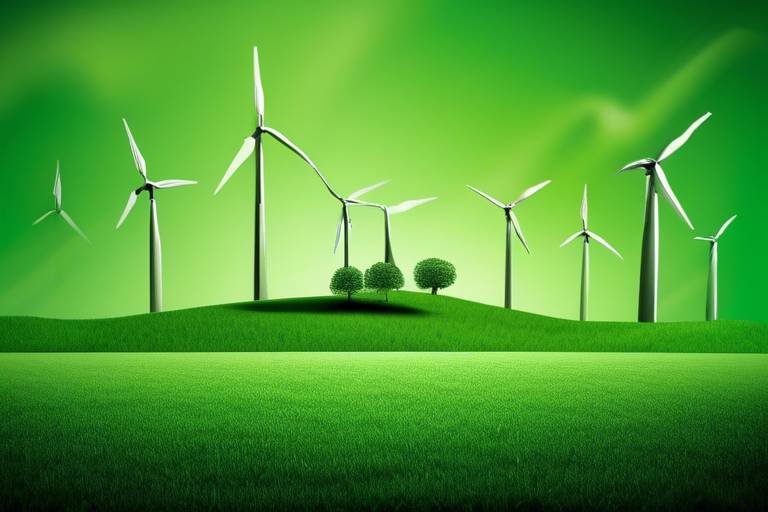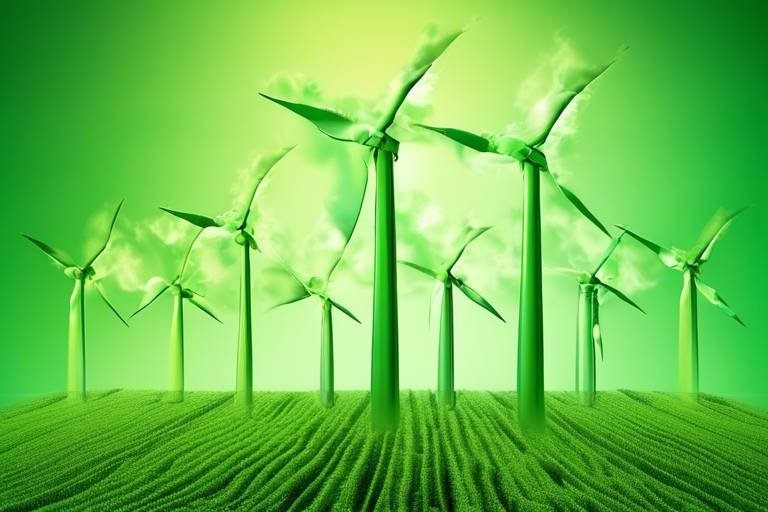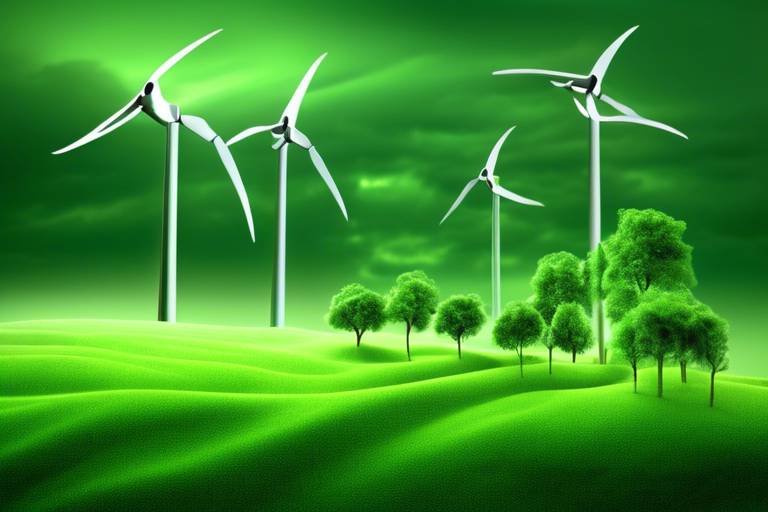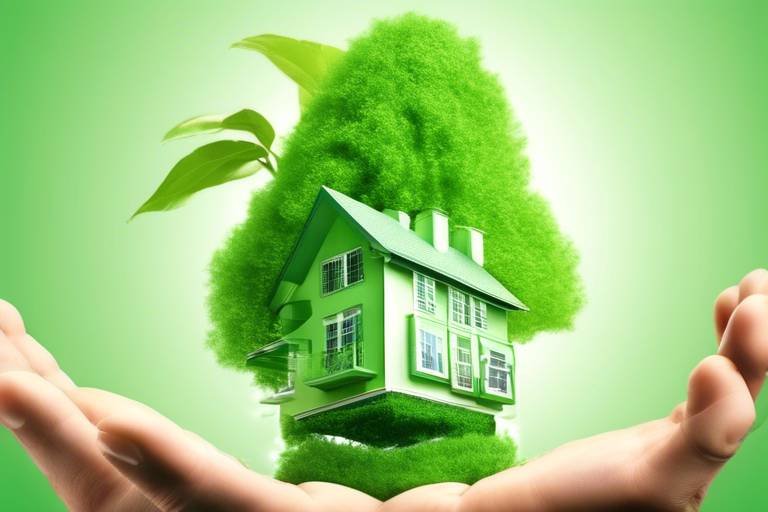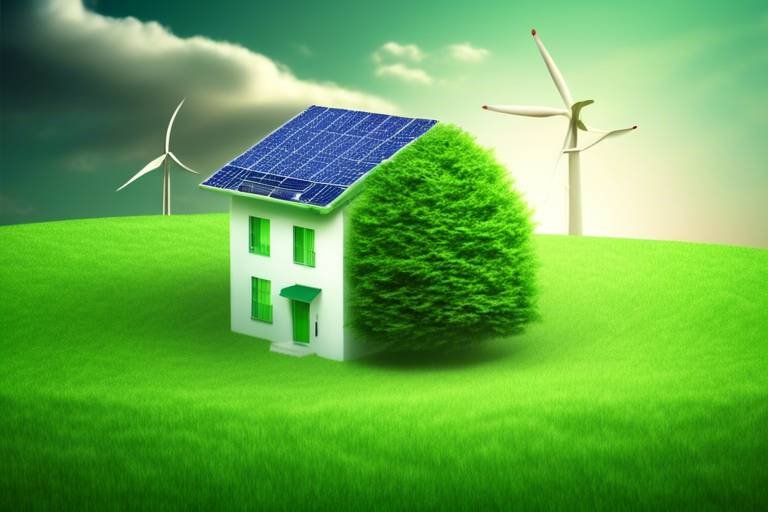Understanding the Role of Energy Efficiency in a Greener Planet
In today's world, the conversation surrounding sustainability has become increasingly urgent. With climate change knocking on our doors and natural resources dwindling, the need for a greener planet is more pressing than ever. One of the most effective ways to tackle these challenges is through energy efficiency. But what does energy efficiency really mean, and why is it so significant? Simply put, energy efficiency refers to using less energy to provide the same service or achieve the same outcome. This can range from using energy-efficient light bulbs to implementing advanced technologies in industrial processes. By embracing energy efficiency, we can significantly reduce our carbon footprints, lower energy costs, and contribute to a healthier environment.
Now, imagine a world where our homes, offices, and cities consume less energy without sacrificing comfort or productivity. It’s not just a dream; it’s a reality that can be achieved through various strategies and technologies aimed at improving energy efficiency. For instance, retrofitting existing buildings with modern insulation and energy-efficient systems can drastically cut down on energy consumption. This not only benefits the environment but also enhances the quality of life for the occupants. In essence, energy efficiency is a win-win situation: it helps the planet while also saving money and resources.
Moreover, energy efficiency is not just about individual actions; it's about creating a culture of sustainability. When communities come together to adopt energy-efficient practices, the cumulative effect can lead to significant changes in energy consumption patterns. This collective effort is crucial in the fight against climate change, as it enables us to reduce greenhouse gas emissions on a larger scale. Think of it like a ripple effect—one small action can lead to a wave of positive change.
As we delve deeper into the significance of energy efficiency, we will uncover various strategies and technologies that can help us achieve a greener planet. From upgrading appliances to utilizing smart technologies, the potential for improvement is immense. So, let’s embark on this journey towards understanding how energy efficiency can not only transform our lives but also safeguard our planet for future generations.
- What is energy efficiency? Energy efficiency is the practice of using less energy to perform the same task or function, thereby reducing energy waste.
- Why is energy efficiency important? It helps lower greenhouse gas emissions, reduces energy costs, and enhances the overall quality of life.
- How can I improve energy efficiency in my home? You can improve energy efficiency by upgrading to energy-efficient appliances, improving insulation, and using smart home technologies.
- What are the economic benefits of energy efficiency? Energy efficiency can lead to lower utility bills, increased property values, and job creation in green industries.
- What challenges exist in implementing energy efficiency? Common challenges include upfront costs, lack of awareness, and regulatory barriers.

The Importance of Energy Efficiency
Energy efficiency is not just a buzzword; it is a fundamental principle that can lead to a more sustainable future. By optimizing how we use energy, we can significantly reduce our overall consumption. This is crucial in a world where resources are finite and climate change poses a serious threat to our planet. The importance of energy efficiency extends beyond just saving money; it encompasses a wide array of benefits that contribute to both individual and collective well-being.
First and foremost, energy efficiency plays a critical role in reducing greenhouse gas emissions. According to the U.S. Environmental Protection Agency (EPA), buildings account for nearly 40% of total energy consumption in the U.S. By implementing energy-efficient practices, we can drastically cut down on the carbon footprint associated with energy production and use. This is essential for combating climate change and promoting a healthier environment for future generations.
Furthermore, energy efficiency leads to significant cost savings. Imagine slashing your monthly utility bills simply by upgrading to energy-efficient appliances or improving your home’s insulation. Not only does this free up funds for other essential needs, but it also contributes to overall financial stability. In fact, studies show that households that invest in energy-efficient technologies can save hundreds of dollars annually. This is not just a win for the wallet; it’s a win for the economy as well, as these savings can be reinvested into local communities.
Another important aspect of energy efficiency is its role in enhancing energy security. As we strive to reduce our reliance on fossil fuels, energy efficiency serves as a bridge to a more sustainable energy future. By using less energy, we can lessen our dependence on imported fuels and mitigate the risks associated with fluctuating energy prices. This is particularly important in a global market where geopolitical tensions can affect energy availability and pricing.
Moreover, energy efficiency contributes to improved public health. By reducing emissions from power plants and vehicles, we can decrease air pollution, which is linked to a host of health issues, including respiratory diseases and cardiovascular problems. Cleaner air means healthier communities, and investing in energy efficiency can lead to fewer health-related expenses for families and healthcare systems alike.
In summary, the importance of energy efficiency cannot be overstated. It is a multi-faceted solution that addresses environmental, economic, and health challenges. By making informed decisions about energy use, individuals and organizations alike can contribute to a greener planet. The ripple effects of these choices can lead to a more sustainable world, benefiting not just ourselves but future generations as well.

Key Strategies for Improving Energy Efficiency
When it comes to enhancing energy efficiency, there are several key strategies that can make a significant difference. These strategies not only help in reducing energy consumption but also contribute to a healthier environment. One of the most effective approaches is retrofitting existing buildings. By upgrading older structures with modern energy-efficient technologies, we can drastically improve their energy consumption. Imagine an old building, once a drafty shell, transformed into a cozy, energy-efficient haven. This not only enhances the comfort of its inhabitants but also leads to substantial savings on energy bills.
Another essential strategy is upgrading appliances. Old appliances tend to consume more energy than their newer counterparts. By investing in energy-efficient appliances, households and businesses can save a significant amount on their utility bills. For instance, replacing an old refrigerator with a modern, energy-efficient model can cut energy usage by up to 50%. This is not just about saving money; it's about making a conscious choice to reduce our carbon footprint.
Moreover, utilizing smart technologies has become a game-changer in the realm of energy efficiency. Smart thermostats and energy management systems allow users to monitor and control their energy usage in real-time. With these technologies, you can adjust your heating and cooling systems based on your daily routines, ensuring that energy is not wasted when it's not needed. Imagine coming home to a perfectly heated house without having to run the heater all day. This level of control can lead to substantial energy savings.
To further illustrate the impact of these strategies, consider the following table that summarizes their benefits:
| Strategy | Benefits |
|---|---|
| Retrofitting Buildings | Improved energy consumption, enhanced comfort, reduced operational costs |
| Upgrading Appliances | Lower energy bills, reduced carbon footprint |
| Utilizing Smart Technologies | Real-time monitoring, optimized energy use, significant savings |
In addition to these strategies, it's important to consider the role of insulation in energy efficiency. Proper insulation minimizes heat loss during winter and keeps interiors cool during summer. This leads to significant energy savings and improves indoor air quality, making your home not only more comfortable but also healthier. Furthermore, upgrading HVAC systems to modern, energy-efficient models can drastically reduce energy consumption and lower environmental impacts from heating and cooling.
In conclusion, improving energy efficiency requires a multifaceted approach. By retrofitting buildings, upgrading appliances, utilizing smart technologies, and focusing on insulation and HVAC improvements, we can create a more sustainable future. Each step taken towards energy efficiency is a step towards a greener planet.
- What is energy efficiency? Energy efficiency refers to using less energy to provide the same service or output, which helps reduce energy consumption and greenhouse gas emissions.
- How can I improve energy efficiency in my home? You can improve energy efficiency by retrofitting your home, upgrading to energy-efficient appliances, improving insulation, and using smart technologies.
- What are the financial benefits of energy efficiency? Energy efficiency can lead to lower utility bills, increased property values, and potential tax incentives or rebates.
- Are there any government programs to support energy efficiency? Yes, many governments offer programs and incentives to encourage energy-efficient upgrades, such as tax credits, rebates, and grants.

Retrofitting Existing Buildings
Retrofitting existing buildings is a transformative approach that breathes new life into older structures, enhancing their energy efficiency and overall sustainability. Imagine taking a vintage car, one that has seen better days, and upgrading it with the latest technology to make it not only run smoother but also consume less fuel. That's precisely what retrofitting does for our buildings—it revitalizes them, making them more efficient and environmentally friendly.
When we talk about retrofitting, we're referring to the process of upgrading older buildings with modern energy-efficient technologies. This practice is not just about making a building look good; it’s about significantly improving its energy consumption profile. For instance, by replacing outdated heating systems, installing energy-efficient windows, and adding insulation, we can drastically reduce the energy needed to keep a space comfortable. This is crucial in a world where energy costs are rising and environmental concerns are at the forefront of public consciousness.
One of the most significant benefits of retrofitting is the potential for cost savings. Homeowners and businesses alike can enjoy lower utility bills after making these upgrades. Additionally, retrofitted buildings often see an increase in property value. In fact, studies show that energy-efficient buildings can sell for up to 10% more than their less efficient counterparts. This increase in value is not just a number; it reflects the growing demand for sustainable living spaces.
Moreover, retrofitting contributes to a healthier indoor environment. By improving air quality through better ventilation and reducing moisture issues, occupants can enjoy a more comfortable and safe living or working space. It’s like turning a stuffy room into a fresh, airy oasis. This is particularly important in urban areas where pollution levels can impact health. By enhancing energy efficiency, we’re not just saving money; we’re also investing in our well-being.
However, the retrofitting process does come with its challenges. The initial costs can be daunting, and many building owners may hesitate to invest in upgrades. But the long-term benefits often outweigh these upfront expenses. For those concerned about financing, there are various incentives available, including government grants and tax credits aimed at encouraging energy-efficient renovations.
In summary, retrofitting existing buildings is a vital step toward achieving a more sustainable future. It represents an opportunity to not only reduce our carbon footprint but also to enhance the quality of life for those who inhabit these spaces. As we move forward, embracing retrofitting can be seen as both a practical and ethical choice, aligning our built environment with the needs of our planet.
- What is retrofitting? Retrofitting involves upgrading existing buildings with modern energy-efficient technologies to improve energy consumption and reduce environmental impact.
- How does retrofitting save money? By improving energy efficiency, retrofitting can lead to lower utility bills and increased property values.
- Are there financial incentives for retrofitting? Yes, many government programs offer grants and tax credits to encourage energy-efficient upgrades.
- What are the health benefits of retrofitting? Enhanced air quality and improved comfort levels contribute to a healthier living and working environment.

Benefits of Insulation
Insulation is often regarded as the unsung hero of energy efficiency. Imagine living in a house that feels just right, no matter the season—cool in the summer and warm in the winter. That's the magic of proper insulation. It acts as a barrier against heat transfer, meaning it keeps your home cozy during chilly months and refreshingly cool when the sun is blazing. This dual benefit not only enhances comfort but also leads to significant energy savings.
One of the most compelling benefits of insulation is its ability to reduce energy consumption. When your home is well-insulated, your heating and cooling systems don't have to work as hard to maintain a comfortable temperature. This results in lower energy bills, which can be a game-changer for your budget. On average, homeowners can save between 10% to 50% on their energy costs by investing in proper insulation, depending on the type and quality of the materials used.
Moreover, insulation contributes to a healthier indoor environment. By minimizing drafts and preventing moisture buildup, it helps maintain optimal indoor air quality. This is particularly important for individuals with allergies or respiratory issues. Furthermore, good insulation can reduce noise pollution, creating a quieter, more peaceful living space. You can say goodbye to the sounds of traffic or noisy neighbors, allowing you to enjoy your sanctuary in peace.
Another significant aspect to consider is the environmental impact of insulation. By reducing energy consumption, you are also decreasing your carbon footprint. Less energy usage means less reliance on fossil fuels, leading to a reduction in greenhouse gas emissions. This is a vital step toward combating climate change and promoting a sustainable future. In fact, the U.S. Environmental Protection Agency (EPA) states that proper insulation in homes can prevent millions of tons of carbon dioxide from being released into the atmosphere.
In addition to these benefits, insulation can enhance the overall value of your property. Potential buyers are increasingly looking for energy-efficient homes, and having quality insulation can make your property more attractive in a competitive market. It’s not just about comfort; it’s also about making a smart investment that pays off in the long run.
To summarize, the benefits of insulation extend far beyond mere comfort. Here’s a quick recap:
- Energy Savings: Lower utility bills due to reduced energy consumption.
- Improved Indoor Air Quality: Minimizes drafts and moisture buildup.
- Noise Reduction: Creates a quieter living environment.
- Environmental Impact: Reduces carbon footprint and greenhouse gas emissions.
- Increased Property Value: Makes homes more attractive to potential buyers.
Investing in insulation is not just a home improvement; it’s a step towards a more sustainable and energy-efficient future. So, if you want to enjoy a cozy home, save money, and contribute to a healthier planet, consider upgrading your insulation today!
- What types of insulation are available? There are several types of insulation, including fiberglass, foam board, spray foam, and cellulose. Each has its own advantages and is suitable for different applications.
- How do I know if my home needs insulation? Signs that your home may need insulation include high energy bills, drafts, and fluctuating indoor temperatures. A professional energy audit can provide a comprehensive assessment.
- Can I install insulation myself? While some insulation types can be installed by homeowners, it’s often best to hire professionals, especially for complex areas like attics and walls, to ensure proper installation and effectiveness.
- What is the return on investment for insulation? Many homeowners see a return on investment of 100% or more through energy savings, increased comfort, and enhanced property value.

Upgrading HVAC Systems
Upgrading your HVAC (Heating, Ventilation, and Air Conditioning) system is one of the most impactful steps you can take in improving energy efficiency in your home or business. Think of your HVAC system as the lungs of your building; it circulates air, maintains temperature, and ensures comfort. However, older systems can be energy hogs, consuming more power than necessary and leading to inflated utility bills. By investing in a modern, energy-efficient HVAC system, you can significantly reduce energy consumption and, in turn, lower your carbon footprint.
Modern HVAC systems are designed with advanced technology that not only improves efficiency but also enhances performance. For instance, many new models come equipped with variable speed motors, which adjust the airflow based on the current needs of your space. This means less energy wasted on unnecessary heating or cooling. Additionally, features like smart thermostats allow you to control your system remotely, optimizing energy use even when you're not home.
When considering an upgrade, it's essential to evaluate the SEER (Seasonal Energy Efficiency Ratio) rating of the new system. A higher SEER rating indicates better energy efficiency. For example, a system with a SEER rating of 16 is typically 30% more efficient than one rated at 12. Here’s a quick comparison:
| SEER Rating | Energy Efficiency | Potential Savings |
|---|---|---|
| 12 | Standard Efficiency | Baseline |
| 16 | High Efficiency | 30% Savings |
| 20+ | Ultra Efficiency | 50% Savings |
Moreover, upgrading your HVAC system can lead to improved indoor air quality. New systems often come with advanced filtration technologies that capture dust, allergens, and pollutants, making your home healthier for you and your family. It's like giving your building a breath of fresh air!
While the initial investment for a new HVAC system might seem daunting, the long-term benefits far outweigh the upfront costs. Not only will you enjoy lower energy bills, but you’ll also increase the value of your property. Plus, many utility companies offer rebates and incentives for homeowners who upgrade to energy-efficient systems, making it even more financially viable.
In conclusion, upgrading your HVAC system is not just a step towards energy efficiency; it’s a leap towards a sustainable future. With the right system, you can enjoy comfort, save money, and contribute positively to the environment. So, why wait? Consider making the change today!
- What are the signs that I need to upgrade my HVAC system? If your system is over 10 years old, requires frequent repairs, or your energy bills are rising, it may be time for an upgrade.
- How much can I save by upgrading my HVAC system? Depending on the efficiency of your new system, you could save anywhere from 20% to 50% on your energy bills.
- Are there any incentives for upgrading my HVAC system? Yes, many local utility companies offer rebates and tax credits for energy-efficient upgrades. Check with your provider for specifics.
- How do I choose the right HVAC system for my home? Consult with a professional HVAC contractor who can assess your space and recommend the best options based on your needs and budget.

Utilizing Smart Technologies
In today's fast-paced world, smart technologies are revolutionizing how we approach energy efficiency. Imagine a home where you can control every aspect of your energy use with just a few taps on your smartphone. Sounds futuristic, right? But it's happening right now! Smart technologies, including smart thermostats, energy management systems, and even smart appliances, are designed to optimize energy consumption and reduce waste, making our lives easier and our planet healthier.
One of the most popular smart devices is the smart thermostat. These nifty gadgets learn your heating and cooling preferences over time, adjusting the temperature automatically to match your lifestyle. For instance, if you typically leave for work at 8 AM, your smart thermostat can lower the heating or cooling while you're away, then warm or cool your home just before you return. This not only enhances comfort but also significantly cuts down on energy bills.
Moreover, energy management systems provide a comprehensive overview of your energy consumption. By monitoring your usage in real-time, these systems help identify patterns and suggest adjustments to maximize efficiency. For example, you might discover that your energy use spikes during certain hours due to specific appliances. With this knowledge, you can shift your usage to off-peak times, ultimately saving money and reducing strain on the grid.
But the magic doesn't stop there! Smart appliances, such as refrigerators, washing machines, and dishwashers, are also becoming more energy-efficient. These devices are equipped with sensors and connectivity features that allow them to operate at optimal times and settings. For instance, a smart washing machine can schedule its cycles during off-peak hours when electricity rates are lower, ensuring you save money while being eco-friendly.
To sum it up, utilizing smart technologies is a game-changer for energy efficiency. Not only do they provide convenience and control, but they also empower us to make informed decisions that benefit our wallets and the environment. As we continue to embrace these innovations, the potential for reducing our carbon footprint grows exponentially.
- What are smart technologies? Smart technologies are devices and systems that use connectivity and automation to optimize performance and enhance user control over energy consumption.
- How do smart thermostats save energy? Smart thermostats learn your habits and adjust heating and cooling settings automatically, reducing energy use when you're not home.
- Can I control smart appliances remotely? Yes, most smart appliances can be controlled via smartphone apps, allowing you to monitor and adjust their settings from anywhere.
- Are smart technologies expensive to install? While there may be an initial investment, the long-term savings on energy bills often outweigh the upfront costs.

The Economic Benefits of Energy Efficiency
Investing in energy efficiency is not just a noble endeavor for the planet; it also has a profound impact on our wallets. Imagine slashing your monthly utility bills while simultaneously boosting the value of your home. Sounds like a win-win, right? By adopting energy-efficient practices, households and businesses alike can experience significant cost savings, which can free up funds for other essential needs, enhancing overall financial stability.
Energy-efficient appliances and systems are designed to use less energy while maintaining performance. For instance, switching to LED lighting can reduce energy consumption by up to 75% compared to traditional incandescent bulbs. This simple change can lead to substantial savings over time. In fact, the table below illustrates the potential savings from various energy-efficient upgrades:
| Upgrade Type | Average Annual Savings |
|---|---|
| LED Lighting | $100 |
| Energy-Efficient HVAC | $200 |
| Smart Thermostat | $150 |
| High-Efficiency Appliances | $250 |
Beyond personal savings, energy efficiency also plays a critical role in the broader economy. As businesses adopt energy-efficient practices, they can lower their operational costs significantly. This reduction in expenses can lead to increased profits, which can then be reinvested into the business, leading to job creation in green industries. The push for energy efficiency is not just a trend; it's a vital component of economic recovery and sustainability.
Moreover, energy-efficient buildings and homes often see an increase in property values. Buyers are increasingly looking for homes that promise lower utility bills and reduced environmental impact. This growing demand can elevate the market value of energy-efficient properties, making them more attractive to potential buyers. In essence, investing in energy efficiency is akin to putting money into a savings account that grows over time.
In summary, the economic benefits of energy efficiency are multi-faceted. From lower utility bills to increased property values and job creation, the advantages are clear. As we continue to embrace energy-efficient practices, we not only contribute to a healthier planet but also pave the way for a more robust economy.
- What is energy efficiency? Energy efficiency refers to using less energy to provide the same service, reducing energy waste and costs.
- How can I improve energy efficiency in my home? You can improve energy efficiency by upgrading to energy-efficient appliances, improving insulation, and using smart technologies.
- Are there financial incentives for energy-efficient upgrades? Yes, many governments and organizations offer rebates and tax credits for energy-efficient home improvements.
- What are the long-term benefits of energy efficiency? Long-term benefits include reduced energy bills, increased property value, and a positive impact on the environment.

Cost Savings for Households
When it comes to managing household expenses, energy efficiency is a game-changer. Imagine opening your monthly utility bill and seeing a significantly lower amount than you expected. That's the magic of energy-efficient practices and appliances! By making informed choices about energy use, households can not only reduce their carbon footprint but also enjoy substantial financial savings.
Consider this: energy-efficient appliances, such as refrigerators, washing machines, and HVAC systems, are designed to use less energy while providing the same level of performance. This means that while you may pay a bit more upfront for these appliances, the long-term savings can be remarkable. According to studies, households can save anywhere from 10% to 50% on their energy bills just by upgrading to energy-efficient models.
Here's a breakdown of how these savings can add up:
| Appliance Type | Average Annual Savings | Energy Star Rating |
|---|---|---|
| Refrigerator | $100 | Energy Star |
| Washing Machine | $50 | Energy Star |
| HVAC System | $200 | High Efficiency |
| LED Lighting | $75 | Energy Efficient |
Additionally, implementing simple habits can lead to even more savings. For example, using smart thermostats to regulate heating and cooling can save an average of 10% to 15% on energy bills. By programming your thermostat to lower the temperature when you're not home, you're ensuring that you're not wasting energy on heating or cooling an empty house.
Moreover, homeowners can benefit from government incentives and rebates designed to promote energy efficiency. Many local and federal programs offer financial assistance for upgrading to energy-efficient appliances or making home improvements that enhance energy efficiency. These incentives can significantly offset the initial costs, making it easier for families to invest in their future.
In conclusion, the shift towards energy efficiency is not just an environmental decision; it’s a financially savvy one. By embracing energy-efficient practices and technologies, households can enjoy lower utility bills, increased comfort, and a healthier planet. So, why not take that first step toward a more energy-efficient home? Your wallet—and the environment—will thank you!
- What are the most effective ways to improve energy efficiency at home? Simple changes like using LED bulbs, upgrading to Energy Star appliances, and improving insulation can make a big difference.
- Are energy-efficient appliances worth the investment? Yes! While they may have a higher upfront cost, the long-term savings on energy bills often outweigh the initial expense.
- How can I find out if I'm eligible for energy efficiency rebates? Check with your local utility company or government website for information on available rebates and incentives.

Impact on Job Creation
The shift towards energy efficiency is not just a boon for the environment; it also acts as a powerful engine for job creation. As industries pivot to more sustainable practices, new opportunities are emerging in various sectors. For instance, the construction industry is seeing a surge in demand for skilled labor to retrofit existing buildings with energy-efficient technologies. This means more jobs for electricians, insulation specialists, and HVAC technicians, all of whom are essential in making our buildings greener.
Moreover, the manufacturing sector is adapting to produce energy-efficient appliances and materials. This transition is creating roles in research and development, production, and distribution. The growth of green technology companies is also noteworthy, as they require a workforce that is knowledgeable about the latest innovations in energy management systems and smart technologies.
According to a recent report by the International Energy Agency, energy efficiency measures could create millions of jobs globally. For instance, in the United States alone, the energy efficiency sector employed over 2.4 million workers in 2020, and this number is projected to grow as more companies and households adopt energy-saving practices. The table below illustrates some key sectors benefiting from this job growth:
| Sector | Types of Jobs Created | Projected Job Growth |
|---|---|---|
| Construction | Insulation installers, HVAC technicians | 15% over the next decade |
| Manufacturing | Appliance assembly workers, product designers | 10% over the next decade |
| Technology | Energy analysts, software developers | 20% over the next decade |
Furthermore, the push for energy efficiency has a ripple effect on local economies. As businesses grow and hire more employees, they contribute to the community through increased spending and tax revenues. This creates a cycle of economic activity that benefits everyone. The jobs created are not just limited to technical roles; there are also opportunities in marketing, education, and policy advocacy as companies and organizations seek to promote their energy-efficient products and services.
In conclusion, the impact of energy efficiency on job creation is significant and multifaceted. It not only provides immediate employment opportunities but also fosters the development of a skilled workforce that can adapt to the evolving demands of a greener economy. As we continue to prioritize sustainability, the job market will undoubtedly expand, offering a wealth of opportunities for those ready to embrace the future.
- What types of jobs are created by energy efficiency initiatives?
Energy efficiency initiatives create jobs in various sectors, including construction, manufacturing, technology, and education. Roles range from skilled trades like HVAC technicians to positions in research and development.
- How does energy efficiency impact local economies?
By creating jobs and increasing demand for local services, energy efficiency initiatives stimulate economic growth. This leads to higher spending and increased tax revenues, benefiting the entire community.
- What skills are needed for jobs in energy efficiency?
Skills in technical trades, project management, and knowledge of energy-efficient technologies are essential. Additionally, roles in marketing and policy advocacy require strong communication and analytical skills.

Challenges to Implementing Energy Efficiency
Implementing energy efficiency measures is not always a walk in the park. While the benefits are clear, several challenges can stand in the way of progress. One of the most significant hurdles is the upfront costs associated with upgrading systems and technologies. Many individuals and businesses may find it hard to justify the initial investment, especially when immediate financial returns aren't guaranteed. This is akin to planting a seed and waiting for it to grow; it requires patience and resources before you can reap the fruits of your labor.
Moreover, a lack of awareness about energy-efficient options can hinder adoption. Many people simply don't know what technologies are available or how they can drastically reduce energy consumption. This gap in knowledge can create a cycle where individuals and businesses miss out on opportunities to save money and contribute to a greener planet. It’s like having a treasure map but not knowing how to read it; the riches of energy efficiency are there, but without the right guidance, they remain undiscovered.
Another challenge is the regulatory landscape. In some regions, policies and regulations may not support or incentivize energy efficiency improvements. This can create an environment where businesses are hesitant to invest in new technologies due to uncertainty about future regulations. It's a bit like trying to navigate a maze without a map; without clear guidelines, it's easy to get lost and give up. To counter this, stakeholders must advocate for policies that promote energy efficiency and create a supportive framework for investments.
Despite these challenges, there are avenues for overcoming these barriers. For instance, financing options such as grants, rebates, and low-interest loans can alleviate some of the financial burdens associated with energy efficiency upgrades. Additionally, educational campaigns can raise awareness and inform the public about the benefits of energy-efficient practices. When people understand how these changes can positively impact their lives and the environment, they are more likely to take action.
In conclusion, while implementing energy efficiency measures comes with its fair share of challenges, understanding these obstacles is the first step toward overcoming them. By addressing financial barriers, raising awareness, and advocating for supportive regulations, we can pave the way for a more sustainable future. The journey may be tough, but the destination—a greener planet—is worth every effort.
- What are the primary challenges in implementing energy efficiency? The main challenges include upfront costs, lack of awareness, and regulatory barriers.
- How can financial barriers be overcome? Exploring financing options like grants and low-interest loans can help alleviate upfront costs.
- Why is awareness important for energy efficiency? Increased awareness can drive demand for energy-efficient solutions and motivate individuals to make sustainable choices.
- What role do policies play in energy efficiency? Government policies can either promote or hinder energy efficiency improvements, making it crucial for stakeholders to advocate for supportive regulations.

Overcoming Financial Barriers
When it comes to implementing energy efficiency measures, one of the most significant hurdles people face is financial constraints. It’s a bit like wanting to buy a new car but feeling stuck with an old clunker because the funds just aren't there. However, there are ways to navigate these financial barriers and unlock the potential for energy savings that can ultimately lead to a healthier wallet and planet.
Many individuals and businesses hesitate to invest in energy-efficient upgrades due to the upfront costs associated with these improvements. It’s important to understand that while the initial investment might seem daunting, the long-term savings on energy bills can offset these costs significantly. For instance, consider a household that spends approximately $2,000 a year on energy. By investing in energy-efficient appliances and insulation, they could save up to 30% on their energy bills, translating into $600 annually. Over time, these savings can cover the costs of the upgrades themselves.
Fortunately, various financing options and incentives are available to help ease the financial burden. Many governments and utility companies offer programs that provide rebates, tax credits, or low-interest loans for energy efficiency projects. For example, the Energy Star program in the United States offers incentives for homeowners who upgrade to certified appliances. This not only alleviates some of the upfront costs but also encourages more people to make the switch to energy-efficient solutions.
Additionally, community programs and local non-profits often provide resources and support for those looking to improve their energy efficiency. They may offer workshops or informational sessions to educate homeowners about financing options or even assist with the application processes for grants and subsidies. By tapping into these resources, individuals can find the financial help they need to make sustainable choices without breaking the bank.
Moreover, it’s essential to raise awareness about the long-term financial benefits of energy efficiency. Many people simply don’t realize that the investment they make today can lead to substantial savings tomorrow. Educating the public on these advantages can inspire more individuals to take action and invest in energy-efficient technologies and practices.
In summary, while financial barriers can be a significant challenge in the pursuit of energy efficiency, they are not insurmountable. By exploring available financing options, taking advantage of incentives, and raising awareness about the long-term benefits, individuals and businesses can overcome these hurdles and contribute to a greener, more sustainable future.
- What are some common financial incentives for energy efficiency upgrades? Many governments offer tax credits, rebates, and low-interest loans to encourage energy-efficient improvements.
- How can I calculate the potential savings from energy efficiency upgrades? You can estimate savings by comparing your current energy bills with the expected reductions from energy-efficient appliances or upgrades.
- Are there programs that help low-income households with energy efficiency? Yes, many local and federal programs are designed to assist low-income families with energy efficiency improvements, often providing grants or subsidized loans.

Raising Awareness and Education
When it comes to energy efficiency, knowledge is power. The more people understand the benefits and methods of enhancing energy efficiency, the more likely they are to adopt sustainable practices. Education plays a pivotal role in this transformation, creating a ripple effect that can lead to significant environmental benefits. Imagine if everyone knew how simple changes could lead to lower energy bills and a healthier planet—it's a win-win situation!
One of the most effective ways to raise awareness is through community programs and initiatives. Schools, local governments, and non-profit organizations can collaborate to host workshops, seminars, and informational sessions. These events can cover a variety of topics, such as:
- Understanding energy consumption in households
- Identifying energy-efficient appliances
- Learning about government incentives for energy upgrades
Moreover, social media platforms and online campaigns are powerful tools for spreading the word. Creative content—like infographics, videos, and interactive quizzes—can engage a broader audience and make learning about energy efficiency fun and accessible. When people see their friends and family participating in energy-saving initiatives, it creates a community culture that values sustainability.
In addition to community efforts, educational institutions can integrate energy efficiency into their curriculums. Teaching students about the importance of conserving energy and the technologies available can cultivate a generation of environmentally conscious individuals. Imagine a future where children grow up understanding how their actions impact the planet—this is the kind of change we need!
However, raising awareness is not just about education; it’s also about breaking down barriers. Many people still believe that energy-efficient solutions are too expensive or complex. By providing clear information and showcasing real-life examples of successful energy efficiency projects, we can dispel these myths and encourage more individuals to take action.
Ultimately, the goal is to create a culture of sustainability where energy efficiency is not just an option but a norm. When individuals, communities, and organizations come together to prioritize energy efficiency, the collective impact can be monumental. The journey towards a greener planet starts with informed choices, and education is the key that unlocks this potential.
- What are some simple ways to improve energy efficiency at home?
Start by switching to LED lighting, using energy-efficient appliances, and ensuring your home is well-insulated.
- Are there any financial incentives for making energy-efficient upgrades?
Yes, many governments offer tax credits, rebates, and grants for energy-efficient home improvements.
- How can I learn more about energy efficiency?
Look for local workshops, online courses, and community programs dedicated to sustainability and energy efficiency.

The Future of Energy Efficiency
The future of energy efficiency is not just bright; it's positively dazzling! With the rapid evolution of technology and a growing global consciousness about sustainability, we are on the brink of a revolution in how we consume energy. Imagine a world where your home automatically adjusts its energy use based on your habits and preferences—sounds like science fiction, right? Well, it’s becoming a reality thanks to advancements in smart technologies and innovations that are reshaping our approach to energy consumption.
One of the most exciting developments on the horizon is the integration of artificial intelligence (AI) and the Internet of Things (IoT) into our daily lives. These technologies are not just buzzwords; they are powerful tools that can optimize energy management in real time. For instance, smart thermostats learn your schedule and adjust heating and cooling accordingly, ensuring you’re comfortable while minimizing energy waste. The potential energy savings from such innovations could be monumental, leading to a substantial reduction in our overall carbon footprint.
Furthermore, as we look to the future, it's crucial to recognize the role of government policies and regulations in promoting energy efficiency. Policymakers are increasingly aware that sustainable practices are not just beneficial for the planet; they also stimulate economic growth. Incentives for energy-efficient upgrades, such as tax credits and rebates, are becoming more common, making it easier for individuals and businesses to invest in energy-saving technologies. This synergy between technological advancement and supportive policies creates a fertile ground for innovation and widespread adoption of energy-efficient practices.
As we dive deeper into this future, we can expect to see a shift in consumer behavior as well. With greater awareness of the environmental impact of energy consumption, people are becoming more proactive in seeking out energy-efficient options. This cultural shift is crucial; when consumers demand sustainable products and practices, companies will have no choice but to adapt. The result? A marketplace that prioritizes energy efficiency and sustainability, benefiting both the economy and the environment.
In conclusion, the future of energy efficiency is not just about new technologies or policies; it’s about a collective mindset shift towards sustainability. By embracing these changes, we can create a greener planet for generations to come. It’s an exciting time to be part of this movement, as every small step we take towards energy efficiency contributes to a larger goal of ecological health and sustainability.
- What are some examples of energy-efficient technologies? Energy-efficient technologies include LED lighting, smart thermostats, energy-efficient appliances, and solar panels.
- How can I improve energy efficiency in my home? You can improve energy efficiency by upgrading insulation, using energy-efficient appliances, and installing smart home technologies.
- Are there financial incentives for energy efficiency upgrades? Yes, many governments offer tax credits, rebates, and financing options to encourage energy efficiency upgrades.
- What role does government play in promoting energy efficiency? Governments can implement policies, regulations, and incentives that encourage both individuals and businesses to adopt energy-efficient practices.

Emerging Technologies
In the ever-evolving landscape of energy efficiency, are paving the way for a more sustainable future. These innovations are not just buzzwords; they represent a significant shift in how we manage and consume energy. One of the most exciting advancements is the integration of artificial intelligence (AI) into energy systems. AI algorithms can analyze vast amounts of data to optimize energy usage, predict demand, and even adjust energy consumption in real-time. Imagine a smart home that learns your habits and adjusts the heating or cooling based on your preferences, while also minimizing energy waste. This is not science fiction; it's happening now!
Another groundbreaking development is the Internet of Things (IoT). IoT devices are connected gadgets that communicate with each other and provide valuable insights into energy consumption. For instance, smart meters can track energy usage patterns and send alerts when consumption spikes, allowing users to make informed decisions about their energy habits. By utilizing IoT technology, households and businesses can achieve remarkable energy savings.
Furthermore, advancements in renewable energy technologies, such as solar panels and wind turbines, are becoming more efficient and cost-effective. These technologies are not only reducing our reliance on fossil fuels but also integrating seamlessly with smart grids, which enhance the overall efficiency of energy distribution. For example, solar panels equipped with smart technology can adjust their angle to capture maximum sunlight throughout the day, significantly improving energy output.
As we look to the future, it's essential to recognize the role of energy storage technologies. Innovations in batteries, such as lithium-ion and solid-state batteries, are revolutionizing how we store energy generated from renewable sources. This means that energy collected during sunny or windy days can be saved for later use, ensuring a more reliable and consistent energy supply. The combination of these technologies not only enhances energy efficiency but also contributes to a more resilient and sustainable energy grid.
In summary, the emergence of these technologies marks a pivotal moment in our quest for energy efficiency. By embracing AI, IoT, renewable energy advancements, and innovative storage solutions, we can significantly reduce our carbon footprint and promote a healthier planet. The future is bright, and with these tools at our disposal, we can create a more sustainable world for generations to come.
- What are emerging technologies in energy efficiency?
Emerging technologies refer to innovative tools and systems, such as AI, IoT, and advanced energy storage solutions, that enhance energy efficiency and sustainability.
- How does artificial intelligence contribute to energy efficiency?
AI optimizes energy usage by analyzing data to predict demand and adjust consumption in real-time, leading to reduced waste and lower energy costs.
- What role does the Internet of Things play in energy management?
IoT devices track and monitor energy usage, providing insights and alerts that help users make informed decisions about their energy consumption.
- Why is energy storage important for renewable energy?
Energy storage allows for the capture and use of renewable energy generated during peak production times, ensuring a consistent energy supply even when production is low.

Policy and Regulation Trends
As we navigate the complexities of energy efficiency, it's crucial to understand the role of policy and regulation in shaping a sustainable future. Governments around the globe are increasingly recognizing the importance of energy efficiency as a key strategy in combating climate change and promoting economic growth. The trends in policy and regulation are evolving rapidly, and they are designed to create a framework that encourages both individuals and organizations to adopt energy-efficient practices.
One of the most significant trends is the implementation of incentive programs that reward energy-efficient upgrades. These can take the form of tax credits, rebates, or grants aimed at reducing the upfront costs associated with energy-efficient technologies. For example, many states in the U.S. offer financial incentives for homeowners who install energy-efficient appliances or retrofit their homes with better insulation. This not only makes it more financially feasible for individuals to invest in energy efficiency but also stimulates local economies by creating demand for green products and services.
Additionally, regulatory standards are becoming stricter, pushing industries to adopt more energy-efficient practices. For instance, the introduction of energy performance standards for buildings and appliances is a growing trend. These regulations often require new constructions to meet specific energy efficiency benchmarks, which can significantly reduce energy consumption in the long run. As a result, builders and manufacturers are compelled to innovate and improve their processes to comply with these standards.
Moreover, the integration of renewable energy sources into the energy efficiency conversation is gaining traction. Policymakers are recognizing that energy efficiency and renewable energy go hand in hand. Initiatives that promote the use of solar panels, wind turbines, and other renewable technologies often include energy efficiency measures as part of their framework. This holistic approach not only reduces reliance on fossil fuels but also enhances the overall sustainability of energy systems.
To further illustrate these trends, let’s take a look at a simple table summarizing key policy initiatives across different regions:
| Region | Policy Initiative | Description |
|---|---|---|
| United States | Energy Star Program | Encourages energy-efficient products through labeling and consumer awareness campaigns. |
| European Union | EU Energy Efficiency Directive | Sets binding measures to achieve energy savings across member states. |
| Canada | Greener Homes Initiative | Provides grants and loans for home energy retrofits to improve efficiency. |
In summary, the trends in policy and regulation are pivotal in driving the adoption of energy efficiency practices. By offering financial incentives, establishing regulatory standards, and integrating renewable energy solutions, governments are laying the groundwork for a more sustainable future. As these policies evolve, they will continue to shape the landscape of energy efficiency, making it not just a choice but a necessity for a greener planet.
- What is energy efficiency? Energy efficiency refers to using less energy to perform the same task or activity, helping to reduce energy consumption and lower greenhouse gas emissions.
- Why is energy efficiency important? It plays a crucial role in reducing energy costs, minimizing environmental impact, and enhancing energy security.
- How can I improve my home's energy efficiency? You can improve energy efficiency by upgrading appliances, enhancing insulation, and utilizing smart home technologies.
- What are some common financial incentives for energy efficiency? Many governments offer tax credits, rebates, and grants to encourage energy-efficient upgrades.
Frequently Asked Questions
- What is energy efficiency?
Energy efficiency refers to using less energy to perform the same task or achieve the same result. By improving energy efficiency, we can reduce energy consumption, lower costs, and minimize environmental impact.
- Why is energy efficiency important for the environment?
Energy efficiency is crucial for reducing greenhouse gas emissions, which contribute to climate change. By using energy more efficiently, we can decrease our carbon footprint and promote a healthier planet for future generations.
- How can I improve energy efficiency in my home?
You can enhance energy efficiency in your home by upgrading to energy-efficient appliances, improving insulation, sealing leaks, and utilizing smart technologies like programmable thermostats to optimize energy use.
- What are the economic benefits of energy efficiency?
Investing in energy efficiency can lead to lower utility bills, increased property values, and job creation in green industries. It helps households save money and contributes to a more sustainable economy.
- What challenges exist in implementing energy efficiency measures?
Some common challenges include upfront costs, lack of awareness about energy-efficient options, and regulatory barriers. Overcoming these obstacles often requires education, financial incentives, and supportive policies.
- What role do smart technologies play in energy efficiency?
Smart technologies, such as smart thermostats and energy management systems, allow users to monitor and control their energy consumption in real time. These innovations help maximize energy savings and provide insights for better decision-making.
- How can I find financial assistance for energy efficiency upgrades?
Many programs offer financing options, rebates, and incentives for energy efficiency improvements. Checking with local utility companies, government programs, and non-profit organizations can help you find available resources.
- What are some emerging trends in energy efficiency?
Emerging trends include advancements in artificial intelligence, the Internet of Things (IoT), and innovative building materials. These technologies are revolutionizing how we manage energy and enhance efficiency.
- How can policy changes impact energy efficiency?
Government policies and regulations can significantly influence energy efficiency by setting standards, providing incentives, and promoting awareness. Staying informed about these changes can help you navigate the evolving landscape of energy efficiency.

